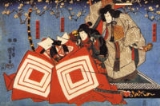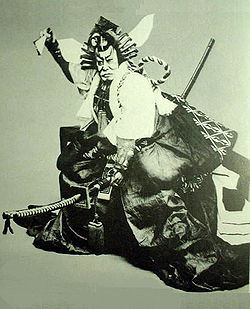
Shibaraku
Encyclopedia

Kabuki
is classical Japanese dance-drama. Kabuki theatre is known for the stylization of its drama and for the elaborate make-up worn by some of its performers.The individual kanji characters, from left to right, mean sing , dance , and skill...
repertoire, and one of the celebrated Kabuki Jūhachiban
Kabuki Juhachiban
The Kabuki Jūhachiban , or Eighteen Best Kabuki Plays, is a set of kabuki plays, strongly associated with the Ichikawa Danjūrō line of actors ever since their premieres. These works were chosen and assembled as "the eighteen" by actor Ichikawa Danjūrō VII . The pieces were considered to be...
(Eighteen Great Plays). The flamboyantly dramatic costume and makeup (kumadori
Kumadori
is stage makeup worn by kabuki actors, particularly when performing in the bold and bombastic aragoto style. Kumadori makeup generally consists of brightly-colored stripes or patterns over a white foundation, the colors and patterns symbolizing aspects of the actor's character...
) used in this scene is famous and widely associated by the average Westerner with Kabuki in general. The English translation of the title is akin to "Stop a Moment!"
Originally staged by Ichikawa Danjūrō I
Ichikawa Danjūrō I
Ichikawa Danjūrō I was an early kabuki actor in Japan. He remains today one of the most famous of all kabuki actors and is considered one of the most influential...
in 1697 at the Nakamura-za, it was very popular, and quickly began to be included at the annual kaomise celebrations of each theatre in Edo
Edo
, also romanized as Yedo or Yeddo, is the former name of the Japanese capital Tokyo, and was the seat of power for the Tokugawa shogunate which ruled Japan from 1603 to 1868...
. For a time, the main role was frequently different, depending on the whims of the theatre and the troupe. The piece was standardized somewhat in the early 19th century by Danjūrō VII, and reworked again by Danjūrō IX
Ichikawa Danjuro IX
Ichikawa Danjūrō IX was one of the most successful and famous Kabuki actors of the Meiji period ....
at the end of that century. This version has been performed since then.
A scene of roughly 50 minutes, Shibaraku is not a play unto itself, but a short drama inserted during interludes or in between full plays to provide variety and maintain a certain level of energy and interest on the part of the audience. The plot centers around the figure of Kamakura Gongorō Kagemasa
Kamakura Gongoro Kagemasa
Kamakura Gongorō Kagemasa was a samurai descended from the Taira clan, who fought for the Minamoto clan in the Gosannen War of Japan's Heian period. He is famous for having continued to fight after losing an eye in battle during that war...
, who has become the stereotypical bombastic hero of the kabuki stage, with red-and-white striped makeup and strong, energetic movement. The historical Kamakura Kagemasa is famous for his bravery for having continued to fight after losing an eye in battle in the Gosannen War
Gosannen War
The Gosannen War , also known by the English translation Later Three-Year War, was fought during Japan's Heian period in the province of Mutsu at the far north of Japan's main island of Honshū. Though some scholars date the war to the period of 1086 to 1089, others place it a few years earlier,...
(1083-1087).
The climactic moment of this short work takes place when a goodly samurai is being assaulted by a number of villains. Kagemasa shouts "Shibaraku!" (Stop a moment!) loudly from behind a curtain (agemaku) and then steps out onto the hanamichi (a raised platform extending through the audience to the stage) in magnificent costume and makeup. Arriving at the stage, he sits on a stool (aibiki) and, in a special kind of monologue called tsurane, explains his story. He then drives the villains off and, as the curtain falls, greets the audience from the hanamichi, not as the hero, but as the actor. The work is derived from an actual occurrence involving Danjūrō I. On this particular occasion, when his fellow actors refused to give him his cue to make his entrance, Danjūrō dramatically shouted "Shibaraku!", and stepped onto the hanamichi, making his entrance.
In 1746 or so, a parody called Onna Shibaraku emerged, which follows the same plot, but with a female role in place of the hero. This piece, too, became standardized, and now follows the form established by Nakamura Shikan V in 1901. The idea of parody is central to the origins, and the nature, of kabuki. This arrangement also allows onnagata, actors devoted to playing female roles, to take part in this most popular of dramatic archetypal stories.

